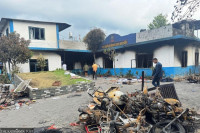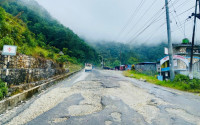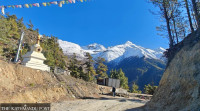Gandaki Province
Paragliding has taken off in Pokhara, but the risks are numerous
In the past year alone, there have been 20 serious accidents involving paragliders, and no one seems to know who is responsible
Sachitra Gurung
When Sushma Sharma took a trip to Pokhara in October 2017, she decided to go paragliding—one of the adventure sports that the lake city is popular for. Sharma only has a hazy memory of what happened up in the air, but the scars imprinted on her tell a story she can’t forget.
About 40 seconds after she had jumped off a hill, strapped to the glider and her pilot, they were struck by harsh winds. Out of control, Sharma crashed onto the ground from a height of 300 feet, breaking her front teeth and suffering multiple fractures, along with minor damage to her spinal cord. She was in intensive care for seven days.
“I have no memory of the 20 minutes before the accident and the two hours after,” said Sharma. “The titanium steel in my neck and my scars are the only reminders of that horrible event.”
A police investigation determined that the accident had occurred due to an “abnormal wind flow” and “unfavourable weather for paragliding”. What Sharma cannot understand is why, despite adverse weather conditions, did the paragliding company and her pilot decide to take the risk.
“The paragliding company didn’t explain anything about safety measures,” said Sharma. “They had assured me that they would follow all safety protocols and their pilots were highly experienced, but that obviously wasn’t the case.”
Paragliding has taken off in Pokhara as a thrilling adventure sport, with over 50 companies providing paragliding services. But a spate of recent accidents has raised questions over the kinds of safety measures paragliding companies have in place, and who is responsible when something goes wrong. In the past year alone, there have been 20 paragliding accidents resulting in serious injuries, according to the Pokhara Police.
Before paragliding, the pilot explains the entire process—from strapping on a parachute and jumping off the cliff to landing procedures—to the passenger 15 minutes before the flight. Flyers are rarely told about possible changes in weather as there is no observation tower to forecast wind speeds, and directions to the pilots. The weather and winds can also be capricious, changing quickly during flight, which is what led to Sharma’s accident.
However, Devendra Pandey, manager of the recreational aviation section at the flight safety department, said that there was no need for a weather tower as a windsock—a textile tube used to determine the wind flow and direction—was present.
“We have weather towers for planes but there is no need to build a weather tower for recreational sports like paragliding,” Pandey told the Post over the phone. “Each flight lasts for 25-30 minutes on average and you can see the landing area from the take-off zone. The pilots are trained to read the weather and clouds.”
Despite Pandey’s confidence, most paragliding operators that the Post spoke with said that Pokhara’s weather was especially erratic and a weather tower would definitely help.
The weather might be to blame, but it is something out of human hands. What can be controlled are the safety measures that the pilots and companies have adopted.
“Accidents caused by unfavourable weather conditions are relatively fewer than accidents caused by miscalculations by solo pilots during landing,” said Inspector Ganesh Subedi of the Pokhara Police.
In Pokhara, there are two types of paragliders—solo and tandem. Tandem flyers carry paying passengers on a thrill ride while solo pilots are trainees, collecting flight hours before they are allowed to carry passengers.
“Most accidents involve solo pilots. Pilots carrying passengers rarely get into accidents,” said Mausam Thakuri, manager of Flying Munky Airventures, a company that provides paragliding services.
Pilots have to go through rigorous training before they can ferry passengers. A pilot has to fly solo for more than a thousand hours, undergo health check-ups, first aid training, and a Simulation d'Incident en Vol, or flight incident simulator, before getting a licence for tandem flights, says Narayan Prasad Parajuli, who operates the Blue Sky Paragliding School in Pokhara.
“During their 18 months of solo flying, pilots have to go through about nine training sessions. Only after that can they apply for a permit for tandem flights,” says Parajuli. “It’s a long process, but anyone in good health and a secondary level education is eligible to become a paragliding pilot.”
In its three years of operation, Parajuli’s school has already produced more than 50 pilots. Earlier, most pilots were foreigners, with just a handful of Nepali pilots who’d learned paragliding abroad.
“Previously, unlicensed pilots and companies without proper registration used to carry out flights, but now that’s become impossible as we monitor them strictly,” said Krishna Bhandari, vice-president of the Nepal Airsports Association, which began regulating paragliding in April. Previously, the Civil Aviation Authority of Nepal (CAAN), the flight regulation agency, also looked over airsports.
Entrepreneurs like Thakuri and Parajuli believe that the future of paragliding looks promising, now that the Airsports Association is in charge.
“The Association has over 20 years of experience regarding paragliding, and as it is based in Pokhara, I think it will be more effective,” said Parajuli.
Already, the Association has instituted new rules towards making paragliding safer. Earlier, both solo and tandem pilots would fly from Sarangkot, but now, solo pilots fly from Mandre danda, making Sarangkot less crowded and lessening the risk of accidents, said Deputy Superintendent of Police Rabindra Man Gurung. There also haven’t been any accidents since the implementation of this rule, he said. Earlier, there were reports of incidents almost every day.
Another safety measure that the Association has instituted allows pilots to only fly one shift a day. Earlier, they would fly up to three shifts a day. There, however, is no fixed number of flights a pilot can make in one shift.
According to the operators, when the weather condition is good, there are around 100-150 flights in a day and each company is allotted a certain time to avoid overcrowding.
“We are currently developing a framework to ensure the safety of both passengers and pilots,” said Basanta Raj Dawadi, general secretary of the Nepal Airsports Association. “We even have mobilised speed boats in Fewa Lake for immediate rescues.”
But there is only so much they can do, said Dawadi. The weather in Pokhara changes frequently and it is difficult to keep track without a proper weather tower, which can provide information in real time. Officials from the Association have had to resort to weather apps on their phone to keep track of the changing weather and wind flows.
“We are now trying to collaborate with Pokhara’s Meteorological Forecasting Division for forecasts,” said Bhandari.
International practice requires paragliding pilots to have a variometer—a device that measures the rate of descent or ascent—a radio and a GPS device during flights. But most commercial tandem pilots in Pokhara carry a GPS and a thermalling device, which measures wind flow and speed; only solo pilots carry a radio.
When accidents happen, as they tend to quite often, there is little recourse that the injured can take.
Sharma wanted to file a case against the paragliding company but was told by the company that “there weren’t any laws for adventure sports in Nepal” and that she could instead claim insurance.
“Recreation aviation companies provide insurance for passengers in case of accidents, injuries, or death,” said Dawadi. “Other than that, there isn’t much we can provide. Even if someone decides to file a case, there are no clear legal measures.”
Gurung, however, said that there are laws related to negligence that could apply in case of accidents. “There are provisions for negligence in the new Criminal Code where offenders can be jailed for three to ten years and fined up to Rs 100,000,” he said.
“Looking back, I feel lucky that I only suffered injuries,” said Sharma. “Just a few feet ahead and I would have fallen into a gorge and could have lost my life. I don’t want anyone else to go through what I did.”




 13.12°C Kathmandu
13.12°C Kathmandu










